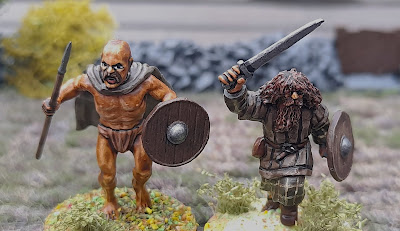With the Second Edition of the Osprey Wargames rules, Lion Rampant, due out any time now, I started thinking about upgrading my Henry II period one-to-one skirmish games to something on a little larger scale. Creating an English retinue for Lion Rampant simply involved combining the small units I'd already painted into larger ones as set out in the rules.
 |
| Donnchad, The Earl of Fife |
The only useful information I can find is from two books I have on my bookshelf, both of which I bought way back in the early 1980s, but I'm happy to base my research on what I have to facilitate getting a retinue painted and onto the table top.
My force is to be lead by Donnchad, the Earl of Fife and I have assumed that he and his Men-at-Arms would be similar to those I've painted up for the English retinue. Four of the six figure unit are simply re-purposed from the figures I painted for King Henry's War, with another, slightly less well armoured, which I painted as a character returned from the Holy Land and, for the last, I decided to risk using a Footsore Pictish armoured figure, as a Highlands or Isles character who, through familial links with the Earl, has found himself joining in on this raid over the border, to secure Northumberland for the Scottish crown! The Earl's standard bearer is the figure I used as Hugo Flambard, with a bit of drilling out to accommodate the standard and a new left arm to wield that mighty blade... what a hero!
fitting some longer metal spears to equip them as
described by Mr. Heath. He also goes on to say, "The shield, which gave its name to the schiltron, was probably fairly
small. Those carried at the Standard are described as “targes” of 'barkened' bull’s hide”. A picture of a 'Lowland Spearman' in the Osprey "Scottish and Welsh Wars" shows a small wooden shield, similar to some that I have from Footsore Miniatures, so those will be pressed into service.
Other descriptions I've read of the Battle of the Standard are less than complimentary on the quality of armour worn by the Scots. Indeed, it appears that the average Scot at the battle hardly wore anything at all, so I've decided that, even if the term "naked" refers to a lack of armour rather than clothing, the majority of the spear armed foot soldiers ought to be classed as Foot Yeomen, and not Serjeants. For these figures I had, tucked away in a cupboard, a box of Gripping Beast Pict infantry and they seem to fit the bill for the more lowly members of the retinue. Again, the plastic spear is replaced with a longer metal one and more Footsore shields complete the ensemble. The Foot Yeomen have the ability to form "Schiltron", which leaves them immobile, but better protected against the enemy onslaught.
I'm keen to include a unit of "Fierce Foot" in my Scots retinue and the Galwegians seem to be ideal candidates to play this role. At the Battle of the Standard, one suggested reason behind the Scottish defeat was that the Galwegian warriors refused to participate unless they had the honour of leading the assault and charge headlong into the opposing ranks of English spearmen. Being "unclothed and remarkable for much baldness", they were cut down in droves by the English archers. Wargames Atlantic's Irish and some of the Victrix Germans fit nicely into the category of "unclothed and remarkable for much baldness", so they, along with some more Footsore Picts, will play the role of the Galwegians in Fife's retinue! To be fair, it appears that the Galwegians did initially drive the English back and continued to attack even when they were "bristling all round with arrows"! So far, I've only completed a couple of the figures for this unit and, as you can see, they vary considerably in appearance but, hopefully, their "fierceness" will be the quality which draws them together as a group!
Finally, the Scottish retinue of the later 12th century requires a unit of Bidowers. For these, I have some Footsore Miniatures' Pictish javelinmen which, I think, will fit the bill quite nicely. As Bidowers are described as a fairly generic missile type in the rules, it seems appropriate to equip them with a mixture of missile weapons, so they wield javelins, slings and I've even managed to fit a crossbow in there as well!



So far, I've been painting parts of units, rather than working through a whole unit at a time, to get an idea of how each group might work. Next job then, is to finish off each unit in turn and then get the Retinue onto the table top, hopefully, just in time for the arrival of the new edition of Lion Rampant!










No comments:
Post a Comment